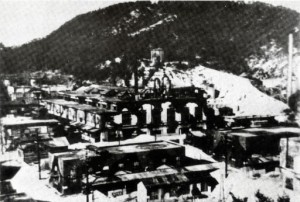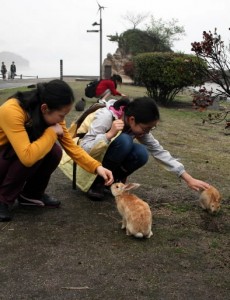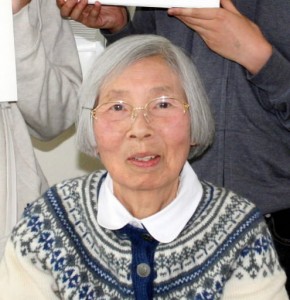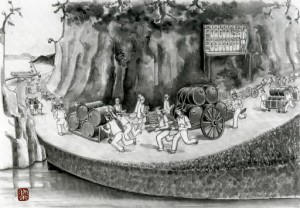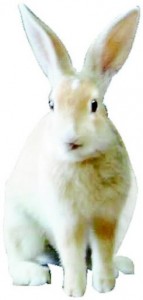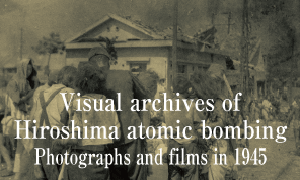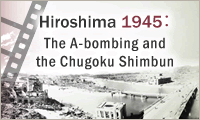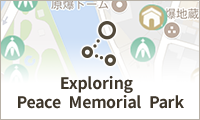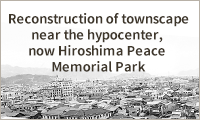Peace Seeds: Teens in Hiroshima Sow Seeds of Peace (Part 8)
May 22, 2015
Part 8: Ohkunoshima Island, peaceful tourist destination, reveals Japan’s history of aggression
Located in the Seto Inland Sea, Ohkunoshima Island has been dubbed “Rabbit Island” because of some 700 wild rabbits living there. Upon arriving at the island, visitors are greeted by rabbits of various colors, such as black, light brown, or spotted, as if stepping into the world of Peter Rabbit.
Today, Ohkunoshima is a popular and relaxing site for tourists, but for 15 years during World War II, poison gas was manufactured on this island.
The ruins of buildings that were used for storing poison gas and for other purposes can still be seen. Standing in front of one of the ruins that rises in tall grass, we felt like we had entered a different world where time had stopped, isolated from the peaceful surroundings. We were taken aback by the fact that deadly chemical weapons were produced on this island during the war.
The atomic bombing of Hiroshima and its aftermath is well known inside and outside Japan. But not many people are aware that poison gas was produced on an island in the same prefecture. We felt strongly that we should recognize this fact and our nation’s responsibility for inflicting harm on others.
Rabbits welcome tourists on island where poison gas was produced
Ohkunoshima is a small island with a circumference of 4.3 kilometers. It is about 10 minutes by ferry from Tadanoumi Port in Takehara, Hiroshima Prefecture. When we arrived at the island, rabbits hopped toward us. There were cries of “Cute!” and all the visitors, children and adults alike, smiled. This is why Ohkunoshima is called “Rabbit Island” or “Island of Healing.”
On the island is a hotel known as the National Park Resort Village Ohkunoshima, and a visitor center run by the Ministry of Environment, where visitors can learn about the natural environment of the island. In fiscal 2014, 186,000 people visited Ohkunoshima.
The island also bears the ruins of factories where poison gas was manufactured and other war-related facilities. Close to the hotel are the ruins of a storage building for poison gas and an air-raid shelter. To the north of some tennis courts is the old Nagaura Posion Gas Storage, a huge structure which once housed six 100-ton tanks.
During the war, Ohkunoshima Island served as a base for the former Imperial Japanese Army to manufacture poison gas. It was a top-secret location and was even removed from maps.
At the Poison Gas Museum, we learned that a total of 6,600 tons of poison gases, including mustard and sneeze gases were produced between 1929 and July 1944, one year before the end of the war. The gases were used in China and other places and many people, including civilians, were killed.
About 6,500 people were engaged in the secret operations involving poison gas on this island. Some of them were students. Workers developed sores on their skin or throat diseases. Many people died and some are still suffering from the aftereffects of this work. Ceramic manufacturing tools, an old protective suit, and photos showing the harm this inflicted to the human body are displayed in the museum, conveying the horrible consequences of poison gas.
Masayuki Yamauchi, 70, the secretary-general of a study group on the history of poison gas production on the island, said, “Poison gas and nuclear weapons are the same in that both do indiscriminate harm to many people. I want people to know that poison gas was produced here. War is terrible. The victims suffer, of course, but people who were involved in the aggression also experience psychological trauma. I hope people will learn this history so that tragic mistakes like this will not be repeated.” (Miku Yamashita, 16, Mei Morimoto, 16, and Riho Kito, 14)
Interview with Reiko Okada, former student laborer: “We were forced to help with the war effort”
The junior writers interviewed Reiko Okada, 85, who worked as a mobilized student on Ohkunoshima Island during the war. Ms. Okada, who lives in Mihara, Hiroshima Prefecture, was a student at Tadanoumi Girls’ High School (now Tadanoumi High School). Between the fall of 1944 and the end of the war the following year, she did not attend school but instead went to the island, where she was assigned to perform such tasks as carrying cans containing poison gas. Though she was only a girl of 15, she was treated like a soldier. She was about as old as we are, but was unable to go to school. This is a big difference between Ms. Okada and us, as we take going to school for granted.
When she worked at the factory, Ms. Okada would get up at six in the morning, have breakfast, and take a train to Tadanoumi Port. She would go to Ohkunoshima Island by boat, and her work would begin with the morning meeting at 8:15 a.m. and end at 4:00 p.m. She had no days off. She was engaged in producing smoke bombs, carrying poison gas cans, and manufacturing parts for balloon bombs, among other jobs. “Carrying the cans was especially hard and dangerous,” she said. She added that toxic substances oozed out of the containers and, by the end of the day, people’s eyes were teary and they were sneezing.
She was tired when she got home. She had dinner and went to bed before 9:00 p.m., leaving her with little free time before going to sleep. During this time, she sometimes managed to read her school books or write in her diary. She was forbidden to talk about what she did on the island, even to family members.
Ms. Okada’s life at the time is very different compared to us because she had no time to spend on her own interests, such as studying. She was deprived of her basic human rights. “We were forced to help with the war effort, and our personal wishes were completely disregarded,” she said. “We didn’t have time to enrich our lives as human beings.”
These days, we’re able to spend time studying. We can freely express our happiness and sadness. We must appreciate what we tend to take for granted. We should help keep the world a peaceful place and treasure each day of our lives. (Marika Tsuboki, 15, and Tokitsuna Kawagishi, 13)
Same attention should be given to Hiroshima and Ohkunoshima
The first nuclear attack in human history wreaked immense damage on the city of Hiroshima. Many people from around the world visit the Hiroshima Peace Memorial Museum in the Peace Memorial Park to learn about the terrible devastation and renew their determination to advance peace. In fiscal 2014, 1,314,000 people visited the museum. On the other hand, relatively little attention is paid to Ohkunoshima Island, which reveals Japan’s history as an aggressor nation.
The Poison Gas Museum attracted 49,500 visitors in fiscal 2014. Although the island is not as accessible or as large as the peace museum location, the gap in visitors between the two seems too wide.
Atomic bombs and poison gas are both weapons of indiscriminate mass killing. They are inhumane weapons and the damage inflicted by these weapons can cause suffering to the victims for a long time. Despite an international treaty which bans the use of poison gas, the Imperial Japanese Army used chemical weapons during the war, mainly in China, and abandoned its unused gases in that country. In 2003, one person was killed and 43 others were injured when toxic substances seeped out of drums that had been left behind in Qiquihar, Heilongjiang Province, China.
The atomic bomb brought damage and suffering to Hiroshima, while Ohkunoshima Island was involved in manufacturing poison gas, which brought damage and suffering to the people of other countries. Both aspects convey the negative legacy of human beings. We must learn about both and hand them down to future generations. When we visit the island to see the rabbits, we should also recognize what the island was like during the war. (Ishin Nakahara, 16, Haruka Shinmoto, 16, and Nanase Shode, 15)
History of Ohkunoshima Island
1927: The entire island is designated military land and the construction of the factory begins.
1929: Production of poison gas begins.
1941: Poison gas production on the island peaks. The Pacific War breaks out.
1943: Students are mobilized to work on the island.
1944: Poison gas production is stopped. Balloons for balloon bombs and other parts are manufactured instead.
1945: World War II ends. Disposal of toxic substances begins the following year.
1963: Ohkunoshima National Vacation Village hotel (now, National Park Resort Village Ohkunoshima) opens.
1985: A monument is erected on the island for poison gas victims.
1988: Ohkunoshima Poison Gas Museum is opened by the City of Takehara and other entities.
2003: Cans containing yperite (mustard gas) are unearthed in Qiquihar, Heilongjiang Province, China. The gas, which is believed to have been made on Ohkunoshima Island, injures 43 and kills one.
2009: Twenty-three suspicious objects are found on the sea floor off Ohkunoshima Island. They are believed to be poison gas shells, some of which are later confirmed to be sneeze gas shells. No serious environmental consequences will result, according to the Ministry of Environment.
Junior writers’ impressions
I was just glad when I learned that we would visit Ohkunoshima Island for this report. But now that I’ve learned more about the island, I really hope that the other side of that place will become known to more people. Visit the island and, along with enjoying the rabbits, learn more about the history of Japan’s wartime aggression. (Ishin Nakahara)
The collection at the museum showed that kendo competitions were held at the poison gas factory. Certificates for technical awards and other honors were also on display. I was surprised that events similar to those held at our schools were held and prizes similar to ours were given at the factory. But people were made to work under harsh conditions, and many people died while working there. We can go to school. We should be thankful for that instead of taking it for granted. (Miku Yamashita)
Ohkunoshima is a beautiful island. The many cute rabbits might make us forget that this was once an island where poison gas was produced. I didn’t know much about the history of poison gas production on the island, but after I looked at photos at the museum and the ruins of the factory, I came to realize that we have to tell many more people about it. (Mei Morimoto)
I went to Ohkunoshima Island for the first time, and the rabbits were the first thing that caught my attention. Then I saw the ruins of the poison gas facilities, the containers of poison gas, and the panels explaining the damage this gas causes to human health, and I felt overwhelmed by their terrible effects. Deadly weapons like this are still being used. If people visit Ohkunoshima and learn how horrible they are, no one would want to use them. (Haruka Shinmoto)
When we got off the ferry, there were cute rabbits welcoming us. I saw many smiles on the island. Who can imagine that deadly weapons were once produced there? After I looked at the exhibits at the museum and the ruins of wartime facilities, pondering the island’s past, the clear eyes of the rabbits looked sad. Through this visit, I felt strongly that we can never realize a peaceful world without looking squarely at the history of aggression. (Nanase Shode)
I learned a lot through this visit to Ohkunoshima Island. While the A-bomb Dome symbolizes the wartime suffering, this island shows how Japan inflicted suffering on others. I want to see things from many different angles. My school will take a field trip to the island, so I hope to deepen my understanding, building on what I learned through this visit. This was a precious experience for me at the end of my spring break. (Riho Kito)
I wrote an article about the differences between life in the past and in the present based on the account of Reiko Okada, who worked on the island during the war. Today, school is the center of our lives, but the students’ lives back then were dominated by their work as mobilized students. And the thing that’s completely different, as Ms. Okada put it, is “people’s feelings were killed.” Her story made me realize that peace means being able to express your feelings freely. (Tokitsuna Kawagishi)
What is Peace Seeds?
Peace Seeds are the seeds of smiles which can be spread around the world by thinking about peace and the preciousness of life from various viewpoints. To fill this world with flowering smiles, 44 junior writers, from the sixth grade of elementary school to the last year of high school, choose themes, gather information, and write articles.
(Originally published on April 23, 2015)

